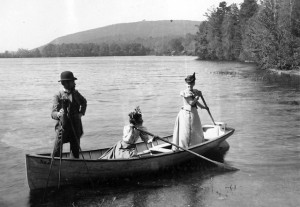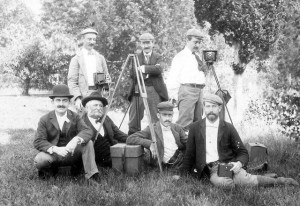True Tales: Images on Glass
By George T. Comeau[Editor’s note: The author has conducted a detailed review of historical records and has found no connection (overt or otherwise) between the naming of the photography club referenced below and the Ku Klux Klan, a hate group that emerged in the 1860s and resurfaced as a national organization in the 1920s. Nevertheless, the Canton Citizen recognizes the historical, social, and emotional significance of the letters “KKK” and failed to acknowledge that significance in the version of this story that appeared in print on September 18. Failing to do so was a mistake on the part of the Citizen’s editorial staff, and we offer our sincerest apology to those who were offended by seeing the reference in print in their hometown newspaper. Furthermore, we welcome our readers to share their reactions to this story and hope to be a conduit for continued discussions around issues of race and diversity and how they impact our community.]
***
They sit piled in small cardboard boxes. Hundreds of pieces of glass that hold a secret view of Canton’s history that dates back to the 1890s. The glass is old and brittle and in some cases pieces have snapped away. These are the glass plate negatives in the photo collection at the Canton Historical Society. And soon, perhaps with your help, these images will be unlocked.
On November 20, 1893, a small group of men gathered at the house of James Draper at eight-o-clock in the evening. The discussion turned to their passion, that of photography. There were many organizations and societies in town, yet this one would be distinguished by a legacy that is still with us today. The men desired to form a group dedicated to recording the present day through their passion for taking and sharing photographs.
All across the country similar groups were springing up. Each month slides were exchanged between Canton and the Manchester Camera Club and then onto the Portland Camera Club, and then proceeding to the New England Photo Exchange. The men would gather and share photos among each other and talk about the techniques that yielded success. Here in Canton, it was wealthy men who formed the membership. This was an expensive hobby that required equipment, chemicals, supplies, and darkrooms.
And when it came time to choose a name, they decided upon the Canton Camera Club. With regret, however, the initials “CCC” were already taken, likely by the Canton Catholic Club, and so they decided to call themselves the Kanton Kamera Klub, and in our historical records became the KKK. They kept meticulous records that detail the activities, membership, and photo trips the club embarked upon. They survived as a group until 1915 and over the course of their 22 years created a vision of our town in black and white on glass.
The early work of the group was to set about the task of soliciting members and creating bylaws. The rules were simple — prints had to be furnished at every meeting for critique, and a fine of $1 was levied for “non-conformity with this rule.” The charter membership included James Draper, Willis B. Shepard, Charles Eager, J.H. Hatfield, R.L. Weston, William Bense, J.D. Dunbar, Herbert Fenno, Edward Underwood, and William Revere. And while from time to time additional members would come and go, this core group was responsible for taking hundreds of photos of Canton and surrounding towns that survive as a visual record today.
One member in particular was extremely talented at the new technology: Frederick Endicott, Canton’s preeminent engineer. Every time you turn the faucet in your house, it is thanks to Endicott, who engineered the Canton water system. So many of his maps and photos survive today due to the fact that he donated so much to the local historical society. A true “Renaissance man,” Endicott mastered the sciences, arts, nature, and a world beyond the four corners of Canton. The fact that Canton is so well understood and measured is a testament to one of our leading civil engineers. His house still stands today and is featured in the “Then and Now” section of today’s paper.
And yet Endicott’s photographs form a separate body of work that is still being understood and processed. In 1895, as a member of the Kamera Klub, he exhibited “some beautiful platinotypes of White Mountain views which he has shown at the Appalachian Mountain Club.” Today, hundreds of these photographs survive at the AMC headquarters in Boston. To take such spectacular views meant hiking up steep mountain paths with heavy equipment and fragile lenses and glass plates. The effort yielded a look above the clouds, and Endicott’s photos were published in some of the earliest guides to the White Mountains. These classic views have stood the test of time and are epic in scale.
Other photographers included members of the Revere family as well as local artists and naturalists. Yet among all the photos, perhaps the finest ones and most artistic were produced by Herman Winslow Spooner. Born in Boston in 1870, Spooner’s father, Edwin, was a barometer manufacturer in Somerville. As a young boy Herman must have shown a proclivity towards scientific instruments. Establishing himself as a civil engineer, surveyor, architect and draughtsman, Spooner found himself engaged in work in Canton in the mid 1890s. It is likely that Spooner was quite close to Endicott as it was Spooner who supervised the installation of the water lines and construction of the wells for the Canton water system. In June 1896, Spooner married a Canton girl, Sarah Nutting, and by the year 1900 they had relocated to Gloucester.
Photography would become art in the hands of H.W. Spooner. After leaving Canton, Spooner became a member of the Cape Ann Camera Club. The influences of Gloucester and the end of the age of the clipper ship became the subject of some of Spooner’s finest photography of the period on the north shore.
But there are photos that Spooner left behind with the Kamera Klub that helps define the sharp eye and the talent of the young man. In an image taken in August 1898 at Mansfield’s Dam, Spooner places a boy balanced on a rock as the water flows around the young lad. The boy has a smirk on his face and is holding a long stick for balance. It’s an idyllic summer scene captured and frozen for all time.

A photo expedition across Ponkapoag Pond where the women did all the work (Courtesy of the Canton Historical Society)
The Kanton Kamera Klub was largely a social group that gathered in each man’s home monthly to shoot the breeze, smoke cigars, and assess each other’s photo talents. The journals of the group are filled with crazy stories, including one in which a “loon” commits suicide in Reservoir Pond after being approached by the camera. The “klub” was limited to 15 members, owing to the fact that not that many people could afford the hobby, but also because they meant to keep a certain exclusivity. Each month the role call elicited groans, as only five or six members would show up. The minutes faithfully record the scene: “The fact that so many members were again absent called forth some spicy remarks regarding their non-appearance. It was thought, rather than deal harshly with the absentees, it would be wiser, in order to awaken their waning interests, to hold out some inducement to entice them to the next meeting. Some had an idea if the treasurer would allow himself to be hypnotized they could secure the large amount he was said to have concealed in an old stocking, and put it to better use.”
Because photography is so technical, the study of process and materials was a consistent topic of the group. Salesmen of the major photo supply companies would visit the group and demonstrate their wares. On some occasions members would do demonstrations. An early flash photography demonstration in 1897 was met with limited success. “Mr. Shepard kindly volunteered to entertain the members with an example of flash-light photography by taking a picture of them in a group. After crowding them into as small a space as possible for fear that some would be left out and darkening the room, the [flash] was fired, there was a terrible glare, and the ordeal was over. Everybody behaved with remarkable coolness. He deftly developed the plate, and after putting it to soak he requested an adjournment to the dining room. A dainty lunch regaled the inner man and reinforced for the fray. They left the plates for the plate, which by this time was ready for examination. It was perceived at once that there was a space on either side of the group for absent members but a shadow hung over them, for which many tried to account in various ways but which, no doubt, was the shadow cast over the Klub by some of the members who resigned without paying their dues. The picture otherwise was a success.”
It is thanks to the Kamera Klub that we have an amazing body of work that needs to be protected and preserved. In the 1970s the Historical Society gathered all the glass plates and placed them in a cabinet in the basement of their headquarters. Today, the glass plates are about to be preserved using state-of-the-art cleaning and storage techniques. Using advanced scanners, details are emerging that show Canton between 1885 through 1910 in a way never before seen, even when the negatives were originally printed. In fact, you might just want to help. In early October, Fred Mirliani from the Photographic Preservation Center in Cambridge will briefly discuss the history of glass-plates, talk about their physical makeup, and then demonstrate cleaning and archiving techniques. Mirliani will provide the necessary equipment to clean and house 100 plates and set up six workstations for hands-on training.
Consider joining a small group of Canton citizens who will place history in their hands, hold it up to the light, and see our town in views that have not been seen in over a hundred years.
To assist in the cleaning, cataloging, and storing of the glass plate negative collection at the Canton Historical Society, simply email the author at geocomeau@gmail.com.
Short URL: https://www.thecantoncitizen.com/?p=26872











